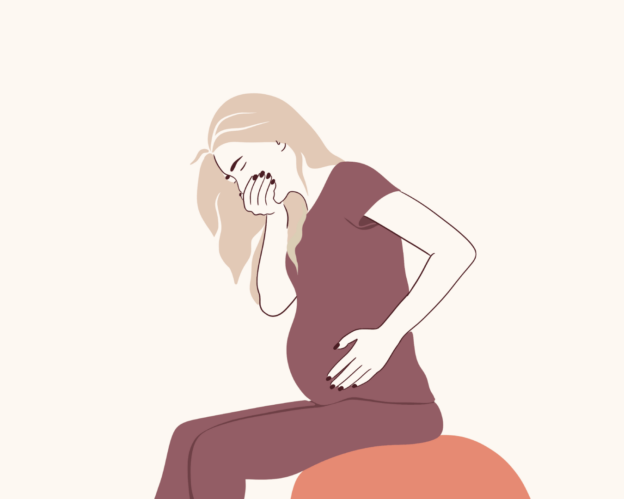Geschreven door Leonie Flipse
Gepubliceerd op 23 augustus 2023
Update mei 2025 door Margot van Dijk
Hyperemesis gravidarum (HG) is een extreme vorm van misselijkheid en/of braken tijdens de zwangerschap die een sterk negatieve invloed hebben op het dagelijks functioneren en zowel voor moeder als kind potentieel levensbedreigend kan zijn. HG kan zowel de gehele zwangerschap duren als na enige tijd weer overgaan en er zijn verschillende gradaties en vormen mogelijk. Aangezien 74% van de vrouwen last hebben van misselijkheid en/of overgeven in de zwangerschap in het eerste trimester, is de grens tussen fysiologische misselijkheid en HG soms lastig te stellen.
Er is voorheen weinig onderzoek naar HG gedaan en pas in januari 2025 is (eindelijk!) de richtlijn Hyperemesis Gravidarum gepubliceerd. Gezien de zeer recente publicatie van de richtlijn is de behandeling van HG in Nederland mogelijk nog wisselend per regio en soms verre van optimaal. Dit artikel vat de laatste literatuur samen van het ontstaan van HG, tot de diagnose en behandeling. Voor zorgverleners en zwangeren een handig overzicht om compleet en goed op de hoogte te zijn van een voorheen ondergeschoven, maar potentieel levensbedreigende aandoening voor zowel moeder als kind.

| Mijn naam is Leonie Flipse-’t Jong en ik ben de schrijver van het artikel over Hyperemesis Gravidarum. Ik ben met veel plezier werkzaam als eerstelijns verloskundige bij de Geboortezaak in Wijk bij Duurstede eo. en daarnaast ben ik trotse moeder van onze dochter Jenthe. Tijdens haar zwangerschap heb ik helaas zelf ondervonden hoe het is om Hyperemesis Gravidarum te hebben en ook dat de zorg voor deze moeders nog (sterk) kan verbeteren. Ik heb dit artikel dan ook geschreven om de zorg voor iedereen die dit ook gaat overkomen een stukje beter te maken, want leuk is het zeker niet, maar zonder goede zorgverlening is het allemaal nog een stuk erger (en gevaarlijker voor moeder en kind). Mijn doel is dat niemand met Hyperemesis zich niet gehoord voelt en/of niet adequaat geholpen wordt door verloskundige zorgverleners (en dat ze niet meer te horen krijgen dat het tussen hun oren zit, ze het kindje dan vast niet willen of zich niet zo moeten aanstellen). Iemand met een ernstige hoge bloeddruk krijgt immers ook medicatie aangeboden in plaats van een stukje gember. |
Bellad, A. V., Shrinivas, B., Arif, M., & Suhas. (2015). A Rare Case of Wernicke’s Encephalopathy Due to Hyperemesis Gravidarum. Online Journal of Health & Allied Sciences, 14(1). https://ojhas.org/issue53/2015-1-3.pdf
Colodro-Conde, L., Jern, P., Johansson, A., Sánchez-Romera, J. F., Lind, P. A., Painter, J. N., Ordoñana, J. R., & McIntosh, A. M. (2016). Nausea and Vomiting During Pregnancy is Highly Heritable. Behavior Genetics, 46(4), 481–491. https://doi.org/10.1007/s10519-016-9781-7
Dean, C., & O’Hara, M. (2015). Ginger is ineffective for hyperemesis gravidarum, and causes harm: an internet based survey of sufferers. MIDIRS Midwifery Digest, 25. 6. Emesafene. (z.d.).
Apotheek.nl. https://www.apotheek.nl/producten/emesafene Fejzo, M. S., MacGibbon, K., First, O., Quan, C., & Mullin, P. M. (2022). Whole‐exome sequencing uncovers new variants in GDF15 associated with hyperemesis gravidarum. Bjog: An International Journal Of Obstetrics And Gynaecology, 129(11), 1845–1852. https://doi.org/10.1111/1471-0528.17129
Grooten, I. J., Roseboom, T. J., & Painter, R. C. (2015). Barriers and Challenges in Hyperemesis Gravidarum Research. Nutrition and metabolic insights. https://doi.org/10.4137/nmi.s29523
Havnen, G. C., Truong, M. B., Huynh, M., DO, Heitmann, K., Holst, L., & Nordeng, H. (2019). Women’s perspectives on the management and consequences of hyperemesis gravidarum – a descriptive interview study. Scandinavian Journal of Primary Health Care, 37(1), 30–40. https://doi.org/10.1080/02813432.2019.1569424
HER Foundation. (2023). HG Treatment Algorithm - HER Foundation. https://www.hyperemesis.org/tools/hg-treatment-algorithm/ ICHG 2022: Prof. Sir Stephen O’ Rahilly – GDF15. (2022).
Stichting ZEHG. https://www.zehg.nl/ichg-2022-prof-sir-stephen-o-rahilly-gdf15/ Ismail, S. Z., & Kenny, L. C. (2007). Review on hyperemesis gravidarum. Best Practice & Research in Clinical Gastroenterology, 21(5), 755–769. https://doi.org/10.1016/j.bpg.2007.05.008
Jansen, L. A. W., Koot, M. H., Van ’t Hooft, J., Dean, C. R., Bossuyt, P. M., Ganzevoort, W., Gauw, N., Van Der Goes, B., Rodenburg, J., Roseboom, T. J., Painter, R. C., & Grooten, I. J. (2021). The windsor definition for hyperemesis gravidarum: A multistakeholder international consensus definition. European Journal of Obstetrics & Gynecology and Reproductive Biology, 266, 15–22. https://doi.org/10.1016/j.ejogrb.2021.09.004
Koot, M. H., Grooten, I. J., Post, J. V., Bais, J. M., Ris-Stalpers, C., Naaktgeboren, C. A., Niemeijer, M., Bremer, H., Van Der Ham, D., Heidema, W. M., Huisjes, A. J., Kleiverda, G., Kuppens, S., Van Laar, J., Langenveld, J., Van Der Made, F., Papatsonis, D., Pelinck, M., Pernet, P., . . . Painter, R. C. (2020). Ketonuria is not associated with hyperemesis gravidarum disease severity. European Journal of Obstetrics & Gynecology and Reproductive Biology, 254, 315–320. https://doi.org/10.1016/j.ejogrb.2020.08.014
Li, L., Zhou, X., Xiao, S., Gu, H., & Zhang, G. (2015). Helicobacter pylori Infection Is Associated with an Increased Risk of Hyperemesis Gravidarum: A Meta-Analysis. Gastroenterology Research and Practice, 2015, 1–13. https://doi.org/10.1155/2015/278905
Lonsdale, D., & Marrs, C. (2017). Thiamine Deficiency Disease, Dysautonomia, and High Calorie Malnutrition. Academic Press. Maag Lever Darm Stichting. (2023). Helicobacter pylori - Maag Lever Darm Stichting. https://www.mlds.nl/ziekten/helicobacter-pylori-infectie-met/
MacGibbon, K. W., Fejzo, M. S., & Mullin, P. M. (2015). Mortality Secondary to Hyperemesis Gravidarum: A Case Report. Women’s Health & Gynecology. Manzo, G., De Gennaro, A., Cozzolino, A., Serino, A., Fenza, G., & Manto, A. (2014). MR Imaging Findings in Alcoholic and Nonalcoholic Acute Wernicke’s Encephalopathy: A Review. BioMed Research International, 2014, 1–12. https://doi.org/10.1155/2014/503596
Meclozine. (z.d.). Apotheek.nl. https://www.apotheek.nl/medicijnen/meclozine
Metoclopramide. (z.d.). Apotheek.nl. https://www.apotheek.nl/medicijnen/metoclopramide
Nana, M., Tydeman, F., Bevan, G., Boulding, H., Kavanagh, K., Dean, C., & Williamson, C. (2021). Termination of wanted pregnancy and suicidal ideation in hyperemesis gravidarum: A mixed methods study. Obstetric Medicine, 15(3), 180–184. https://doi.org/10.1177/1753495x211040926
Niemeijer, M. N., Grooten, I. J., Vos, N., Bais, J. M., Van Der Post, J. A. M., Mol, B. W., Roseboom, T. J., Leeflang, M. M., & Painter, R. C. (2014). Diagnostic markers for hyperemesis gravidarum: a systematic review and metaanalysis. American Journal of Obstetrics and Gynecology, 211(2), 150.e1-150.e15. https://doi.org/10.1016/j.ajog.2014.02.012
Nijsten, K., Dean, C., Van Der Minnen, L. M., Bais, J. M., Ris-Stalpers, C., Van Eekelen, R., Bremer, H. A., Van Der Ham, D. P., Heidema, W. M., Huisjes, A. J., Kleiverda, G., Kuppens, S., Van Laar, J. O. E. H., Langenveld, J., Van Der Made, F., Papatsonis, D. N., Pelinck, M. J., Pernet, P. J., Van Rheenen-Flach, L., . . . Painter, R. C. (2021). Recurrence, postponing pregnancy, and termination rates after hyperemesis gravidarum: Follow up of the MOTHER study. Acta Obstetricia et Gynecologica Scandinavica, 100(9), 1636–1643. https://doi.org/10.1111/aogs.14197
Nijsten, K., Van Der Minnen, L. M., Dean, C., Bais, J. M., Ris-Stalpers, C., Van Eekelen, R., Bremer, H. A., Van Der Ham, D. P., Heidema, W. M., Huisjes, A. J., Kleiverda, G., Kuppens, S., Van Laar, J. O. E. H., Langenveld, J., Van Der Made, F., Papatsonis, D. N., Pelinck, M. J., Pernet, P. J., Van Rheenen-Flach, L., . . . Painter, R. C. (2022). Depression, anxiety, and post-traumatic stress disorder symptoms after hyperemesis gravidarum: a prospective cohort study. Journal of Maternal-fetal & Neonatal Medicine, 35(25), 10055–10063. https://doi.org/10.1080/14767058.2022.2089550
Nijsten, K. (2022). Hyperemesis gravidarum: Maternal and neonatal future health. Universiteit Van Amsterdam. https://hdl.handle.net/11245.1/054bf186-9fd1-4375-8842-921998b888ec
Omeprazol. (z.d.). Apotheek.nl. https://www.apotheek.nl/medicijnen/omeprazol?product=maagzuurremmer-omeprazol
Ondansetron. (z.d.). Apotheek.nl. https://www.apotheek.nl/medicijnen/ondansetron?product=ondansetron
Ondansetron en andere serotonine-antagonisten bij misselijkheid tijdens de zwangerschap. (z.d.). https://www.lareb.nl/mvm-kennis-pagina?id=83&pagina=1&zoekterm=A04AA01&zwangerschap=True&borstvoeding=False
Oratie Professor Rebecca Painter. (2022). Stichting ZEHG. https://www.zehg.nl/oratie-professor-rebecca-painter/
Pacei, F., Tesone, A., Laudi, N., Laudi, E., Cretti, A., Pnini, S., Varesco, F., & Colombo, C. (2020). The Relevance of Thiamine Evaluation in a Practical Setting. Nutrients, 12(9), 2810. https://doi.org/10.3390/nu12092810
Painter, R. (2022). Oratie Professor Rebecca Painter. Stichting ZEHG. https://www.zehg.nl/oratie-professor-rebecca-painter/
Poursharif, B., Korst, L. M., MacGibbon, K., Fejzo, M. S., Romero, R., & Goodwin, T. M. (2007). Elective pregnancy termination in a large cohort of women with hyperemesis gravidarum. Contraception, 76(6), 451–455. https://doi.org/10.1016/j.contraception.2007.08.009
Stichting ZEHG. (2023, 24 februari). Welkom bij Stichting ZEHG - Stichting ZEHG. https://zehg.nl/ University of Bergen. (2019). European antiemetic regulations (restricting metoclopramide use) increases admission rates due to hyperemesis gravidarum. https://static1.squarespace.com/static/5a5dd5e2d74cffb3eaffbbc9/t/5da5d28e80e02e6421c0330d/1571148432477/Lone+Holst%5B80032%5D.pdf?fbclid=IwAR1biNonKrcSIJ0HtdNUgWOJhNqXWvyrOa4qN5Z8_Fa1nwVZ3zILUeup_iY
Van Der Weerd, N., Cats, A., Thijs, J., Festen, H., Meuwissen, S., & Kuipers, E. (2000, 21 juli). Dalende prevalentie van Helicobacter pylori: consequenties voor de behandeling van gastroduodenale ulcera.
NTvG. https://www.ntvg.nl/artikelen/dalende-prevalentie-van-helicobacter-pylori-consequenties-voor-de-behandeling-van#:~:text=In%20westerse%20landen%20ligt%20de,berust%20op%20een%20leeftijdscohort%2Deffect.
Veenendaal, M., Van Abeelen, A. F. M., Painter, R. C., Van Der Post, J., & Roseboom, T. J. (2011). Consequences of hyperemesis gravidarum for offspring: a systematic review and meta-analysis. Bjog: An International Journal Of Obstetrics And Gynaecology, 118(11), 1302–1313. https://doi.org/10.1111/j.1471-0528.2011.03023.x
Vikanes, Å., Skjærven, R., Grjibovski, A. M., Gunnes, N., Vangen, S., & Magnus, P. (2010). Recurrence of hyperemesis gravidarum across generations: population based cohort study. BMJ. https://doi.org/10.1136/bmj.c2050
Xiong, G., & Bienenfeld, D. (2015). Wernicke-Korsakoff Syndrome Treatment & Management: Approach Considerations, Diet and Activity, Referral and Follow-Up Care. Emedicine.Medscape.Com.
Zhang, Y., Cantor, R. M., MacGibbon, K., Romero, R., Goodwin, T. E., Mullin, P. M., & Fejzo, M. S. (2006). Familial aggregation of hyperemesis gravidarum. American Journal of Obstetrics and Gynecology, 204(3), 230.e1-230.e7. https://doi.org/10.1016/j.ajog.2010.09.018
Zwangerschap en kraamperiode. (2023). NHG-Richtlijnen. https://richtlijnen.nhg.org/standaarden/zwangerschap-en-kraamperiode#samenvatting-misselijkheid-en-braken
>




Reacties